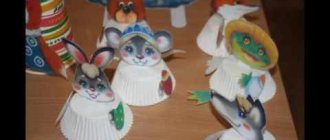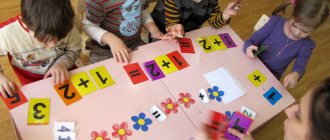Games by theme
- For preschoolers (senior and preparatory groups). Games with rules. Board games, card games, lotto, dominoes, construction sets, puzzles, checkers and chess...
- For young children (junior and middle groups). Development of fine motor skills and coordination, first acquaintance with color, shape and size. Choose by color, screw on the lid, insert a button, braid your hair, games with clothespins, lacing, find a pair, sensory mats and corners, collect beads, felt toys...
- REMP. Formation of ideas about number and quantity, size, shape. Development of spatial orientation, familiarity with time. Count, find the figure, determine the size, logic problems, counting sticks, geocont, tangram, puzzles, geometric lotto, abacus, clock...
- Formation of a sense of rhythm, development of musical perception, familiarity with notes. Musical instruments, homemade noise instruments, games with notes and sounds, musical corners.
- Acquaintance with folk art, artists and paintings. Development of aesthetic perception, color perception, familiarity with the rules of composition. Arts and crafts, patterns and ornaments, palette, drawing games, make a portrait, put together a landscape...
- Homemade baby books, albums, soft, tactile, lapbooks...
- Consolidating knowledge about natural objects and phenomena, animals and plants. Plants, animals, insects, planet Earth, weather, space, water, sand...
- parts of the day, routine and routine...
- Ecological (landscape), traffic regulations, historical, local history, seasonal...
- Traffic rules, signs, traffic lights, cars, street layouts...
- Development of breathing, articulation, formation of correct sound pronunciation, learning to read and write, sounds, letters. Automation of difficult sounds, exercises with sounds, letters and syllables, vowels and consonants, make up a word, games for breathing development...
- Development of coherent speech, grammatical and lexical structure. Based on literary works, based on reference pictures. Mnemonic tables We form adjectives, coordinate words, use prepositions, formulate questions, games based on fairy tales and literary works...
- Attributes and aids for role-playing games, accessories, clothing, furniture
- Do-it-yourself puppet, finger, tabletop and other types of theaters, masks. Theater corners.
- Carnival, theater, dance and other homemade costumes for children and adults
- Clarification of ideas about the Motherland, native land, its history, the Second World War. Regional component.
- Games of different nations. Games of our grandmothers, our childhood, round dance games.
- Invention games. We train analytical thinking, learn to identify, compare, and solve problems.
- Development of emotions, communication skills. Games for a good mood, little girls, for dating. Mood corners
- Active games outdoors and at home.
- Physical exercises, attributes, finger games.
- Sports and physical education corners, equipment for physical education, sports competitions, relay races. Massage paths
Bunnies (Ozon, My-Shop, KoroBoom)
This is a game that hooks children with almost 100% probability. Even if the kid doesn’t want to play by the rules, he will definitely enjoy putting together a fairytale field like a construction set and playing out simple stories on it. I think the main secret to the success of this board game is the 3D playing field, plus the interesting idea of harvesting in the garden.
To be honest, I bought this board game when my daughter was noticeably older than 2 years old (and she just stuck to it). But I’m including it in the selection of games for the little ones, because we took out the game many times when the kids came to visit, the game always went with a bang. Here the child only needs to count within three, the rules are also simple (only parents need to figure it out first, because the instructions are written quite intricately).
The main objective of the game is to go into the garden through a free hole in the fence and pick cabbage or carrots there (depending on the number of dots dropped). You need to quickly go home with your catch, and then go again for the next portion. Naturally, the winner is the one who reaps the most significant harvest.
Fun races and ladybugs (Ozon, My-shop, KoroBoom)
Here's another simple game for little ones.
A game that teaches patience and perseverance. She also trains the child in simple counting, because during the game you will have to count the number of dots on the cube many times. The winner of the game is the one who collects his ladybug the fastest. Collecting it is not difficult - to do this, you need to roll the corresponding numbers on the die. If you throw out “1” you can take the body of a ladybug, if you throw out “4” you can take one eye, etc. At the same time, you must remember that legs can be attached only when you already have a body, and eyes, nose and antennae - when you already have a head.
Educational game Djeco “Numbers” (Ozon, My-shop)
A very good set for practicing your very first counting skills. The rules present as many as 4 variants of the game, both the most banal (combine numbers and quantities) and the most common ones. We especially liked one of them. Here's the gist of it: each player takes a playing field with empty silhouettes of animals. When throwing the dice, players must fill their fields with chips. We place the number of chips on the field as many as the dice shows up. Moreover, on the last move, exactly as many dots should appear on the cube as there are empty cells left on the field; if you are unlucky, we wait for the next move. Naturally, the winner is the one who is the first to completely collect all the kittens/puppies/hares/ducks.
The number of dots on the cube does not exceed three, so a 2-year-old child can easily handle the counting.
The execution of the set, as usual from Djeco, is excellent, the chips and cards are pleasant to hold in your hands, they are durable and will definitely last a long time. Still, the price for Djeco “Numbers” seems to me too high, and it’s not easy to find a set on sale lately, so I’m posting a scanned version of the game just in case. The kit can be DOWNLOADED HERE .
Types of homemade board games
In our unified information space, it makes no difference who is the manufacturer of board games. The same development can be popular both in European countries and in America or Australia. Types of entertainment are varied, many classifications are closely related. For example, economic theory turns out to be not only a logic game, but also an exciting adventure, and popular walkers are nothing more than a carefully thought-out strategy.
Joint activities bring the family together; at this time you can discuss plans and problems along the way. PHOTO: market.yandex.ru
There are several classifications of board games that are suitable for a wide variety of companies and ages:
- for kids, their main task is development and learning, they teach the child to remember the names of geometric shapes, shapes and sizes;
- fillers or card board games are exciting activities with simple rules that are understandable to both adults and children;
- logical board exercises are aimed at developing thinking, building an interconnected chain of varying degrees of complexity;
- walkers are fairy-tale characters moving sequentially. The themes can be different, for example, horror films, colorful adventures;
- fighting games – they feature direct conflict. The game is played on or without a field, cards with different teams are involved;
- tabletop activities for friendly parties are specially designed for several participants;
- large strategic missions are intended for those with a lot of time;
- wargames are military-tactical battles with a huge number of miniatures, fairly complex rules and a mandatory field.
Having chosen the theme, age and number of participants, you can start making it yourself.
Strategic battles for adults can be designed to hold several tournaments over a long period of time. PHOTO: tdko.su
Lotto (Labyrinth, My-shop, KoroBoom)
And, of course, don’t forget about everyone’s favorite classic games. You can start getting acquainted with lotto as early as one year, I have already written about this. Closer to two years, the child can not only put cards in the right places, but also play according to simple rules with his opponent. Let’s say that dad and child each receive a playing field, and mom takes cards out of the bag in random order (or almost randomly :)) and announces “Who has a hippopotamus?” The first one to collect all the cards on his field wins.
Lotto is also great because while playing you can unobtrusively study any interesting topic - animals, plants, professions, geometric shapes, etc. All names will be remembered by the child quickly and easily.





